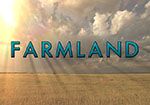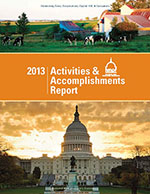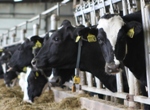 ARLINGTON, VA – America’s dairy farmers, cooperatives, processors, manufacturers, and other industry leaders applaud today’s announcement by the White House of a Biogas and Energy Roadmap to reduce methane emissions from agriculture.
ARLINGTON, VA – America’s dairy farmers, cooperatives, processors, manufacturers, and other industry leaders applaud today’s announcement by the White House of a Biogas and Energy Roadmap to reduce methane emissions from agriculture.
In its announcement, the White House formally cited the work of the Innovation Center for U.S. Dairy’s Sustainability Council, whose efforts in part include a partnership with the U.S. Department of Agriculture to proactively reduce greenhouse gas emissions, including methane.
“This announcement validates the path the dairy industry is on – one focused on proactive incentives that can increase farm income, not punitive regulations that would add more costs,” said Jim Mulhern, president and chief executive officer of the National Milk Producers Federation, which develops and carries out policies that advance the well-being of dairy farmers and the cooperatives they own. “Because of our recent efforts and farmers’ long-standing environmental stewardship, the White House strategy for agriculture includes a commitment to cost-effective, voluntary actions to reduce methane emissions through partnerships and programs.”
A Biogas and Energy Roadmap will be developed in partnership with the dairy industry to accelerate the adoption of biogas systems and other cost-effective technologies. For example, the recovery of nitrogen and phosphorus, valuable soil nutrients, has the potential to make these systems revenue-enhancing for dairy farms of all sizes. The roadmap will help the industry seize these opportunities by:
- Breaking down inter-governmental agency barriers, providing dairy operations access to resources because it formally recognizes biogas systems as a proven and effective technology to mitigate environmental risks;
- Stimulating and accelerating research to advance technologies, such as for extracting nutrients from food waste and manure; and
- Attracting additional third-party investment, both financial and technical, to support the U.S. Dairy Sustainability Commitment.Through the Innovation Center, the dairy industry ramped up its efforts to build business value while reducing environmental impact across the value chain more than five years ago. These efforts provide a way for dairy farm families to turn environmental risks into new revenue streams, and demonstrate farmers’ ongoing commitment to being even better neighbors.
“This is great news for America’s dairy farm families of all sizes across the country,” said Tom Gallagher, chief executive officer of the Innovation Center for U.S. Dairy, which brings together leaders of dairy farmer organizations, cooperatives, processors, manufacturers, and brands to foster innovation. “For decades, dairy farmers have demonstrated a commitment to environmental stewardship, and adopting new practices and technologies along the path to continuous improvement. Our work continues.”
In 2009, the dairy industry established a voluntary goal to reduce its carbon footprint by 25 percent by 2020, and projects are underway across the value chain to accomplish the goal.
Biogas systems have been singled out because of the significant potential they have to help address methane, which are the single largest source of dairy’s greenhouse gas emissions. These systems recycle cow manure and food waste into valuable co-products like fertilizer, renewable energy and cow bedding. New technologies can optimize this potential and deliver economic benefits to dairy farms and those they work with, as well as the communities in which they operate.
“The roadmap makes good sense – not just for dairy, but for rural communities that realize economic benefits, including job creation, through innovation,” Gallagher said.
To learn more about the U.S. Dairy Sustainability Commitment, the reduction goal or the projects and tools currently available, visit www.USDairy.com/Sustainability.
Innovation Center for U.S. Dairy® is a forum for the dairy industry to work together pre-competitively to address barriers and opportunities to foster innovation and increase sales. The Innovation Center aligns the collective resources of the industry against common priorities to offer consumers nutritious dairy products and ingredients, and promote the health of people, communities, the planet and the industry. The Board of Directors for the Innovation Center includes dairy industry leaders representing key producer organizations, dairy cooperatives, processors, manufacturers and brands. The Innovation Center is staffed by Dairy Management Inc™. Visit www.USDairy.com for more information about the Innovation Center for U.S. Dairy.
The National Milk Producers Federation, based in Arlington, VA, develops and carries out policies that advance the well-being of dairy producers and the cooperatives they own. The members of NMPF’s cooperatives produce the majority of the U.S. milk supply, making NMPF the voice of more than 32,000 dairy producers on Capitol Hill and with government agencies.

 A new film that helps connect consumers with both farmers and modern farming practices will be released this spring, thanks to support for the movie generated by the U.S. Farmers and Ranchers Alliance, of which NMPF is a member.
A new film that helps connect consumers with both farmers and modern farming practices will be released this spring, thanks to support for the movie generated by the U.S. Farmers and Ranchers Alliance, of which NMPF is a member. Want to know what NMPF did for dairy farmers last year? Check out the latest edition of the Activities & Accomplishments Report, available on the NMPF website. Published annually, the A&A Report gives members a detailed look at the issues and actions NMPF faces each year.
Want to know what NMPF did for dairy farmers last year? Check out the latest edition of the Activities & Accomplishments Report, available on the NMPF website. Published annually, the A&A Report gives members a detailed look at the issues and actions NMPF faces each year.
 Rule Exceeds the Intent of Congress, Dairy Farmer Group Says
Rule Exceeds the Intent of Congress, Dairy Farmer Group Says ARLINGTON, VA – America’s dairy farmers, cooperatives, processors, manufacturers, and other industry leaders applaud today’s announcement by the White House of a Biogas and Energy Roadmap to reduce methane emissions from agriculture.
ARLINGTON, VA – America’s dairy farmers, cooperatives, processors, manufacturers, and other industry leaders applaud today’s announcement by the White House of a Biogas and Energy Roadmap to reduce methane emissions from agriculture.



